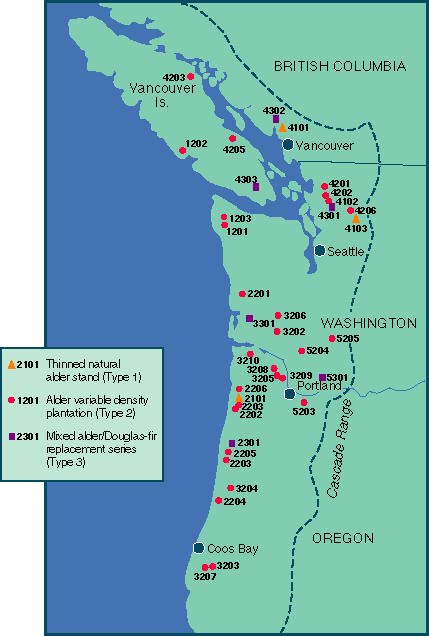Research
The HSC's highest priority is understanding the response of red alder to intensive management. To accomplish this, the HSC has installed 26 variable-density plantations (Type 2) extending from Coos Bay, Oregon to Vancouver Island, British Columbia. The majority of plantations are located in the Coast Range, with a few in the Cascade Range (Type 2 Map). The plantation distribution covers a wide range of geographic conditions and site qualities (Type 2 Matrix). At each site, cooperators planted large blocks of red alder at densities of 100, 230, 525, and 1200 trees per acre. Each block is subdivided into several treatment plots covering a range of thinning and pruning options (up to twelve total treatments per site) (Type 2 Treatments). These sites were established over a 9 year period, starting as far back as 1989 and continuing until 1997 (Type 2 Dates). These oldest sites are some of the oldest alder plantations in existence!
In addition to the 26 variable-density plantations, the HSC has related studies in naturally regenerated stands (Type 1). Young stands (about 15 years old) of naturally regenerated red alder, 5 to 10 acres in size, were pursued as a means of short-cutting some of the lag time before meaningful thinning results could be obtained from the variable-density plantations. It came as a surprise to find only four naturally regenerated stands of the right age and size available in the entire Pacific Northwest (Type 1 Map). At the time of thinning, stand age ranged from 14 to 17 years old (Type 1 Dates). Two of the sites fell into the "early" thin treatments (control, thin to 230tpa, thin to 525tpa) and the other two sites fell into the "late" thin treatments (control, thin to 100tpa, thin to 230tpa) (Type 1 Treatments). We now have over 10 years of post-thinning response data from these sites!
The HSC has also established seven mixed species plantations of red alder and Douglas-fir (Type 3). They are located on land designated as Douglas-fir site class III or below (Type 3 Map). Each plantation is planted with 300 trees per acre with five proportions of the two species. The site layout is designed to look at the interactions between the two species. Other studies have shown that in low proportions and when soil nitrogen is limited, red alder can improve the growth of Douglas-fir. This improvement is due to the nitrogen fixing ability of red alder. The management challenge is to find the right proportion of the two species to maintain a beneficial relationship. Because these sites are fairly young (Type 3 Dates), this beneficial relationship is currently hard to quantify however, treatment effects are readily visible.
Location of existing installations for the Red Alder Stand Management Study.
 HSC research sites are divided into three specific types of installations.
HSC research sites are divided into three specific types of installations.
The three types of study installations are as follows:
- Type 1 are natural alder stand thinned to various densities at various ages
- Type 2 are alder plantations. At each site alder is planted in large blocks of various densities and each block is subdivided into several thinning and pruning treatments.
- Type 3 are mixed plantations of alder and Douglas-fir. Each site is planted to 300 trees per acre with five proportions of the two species.
- ANE-ANE Forests of Oregon.
- BCMin-British Columbia Ministry of Forests.
- BLM-Bureau of Land Management.
- DNR-Washington Department of Natural Resources.
- GYN-Goodyear-Nelson.
- GPNF-Gifford Pinchot National Forest.
- MEN- Menasha Corporation
- MBSNF-Mt. Baker Snoqualmie National Forest.
- ODF-Oregon Department of Forestry.
- OSU-Oregon State University Forest Research Laboratory.
- SNF-Siuslaw National Forest.
- WHC-Washington Hardwood Commission.

